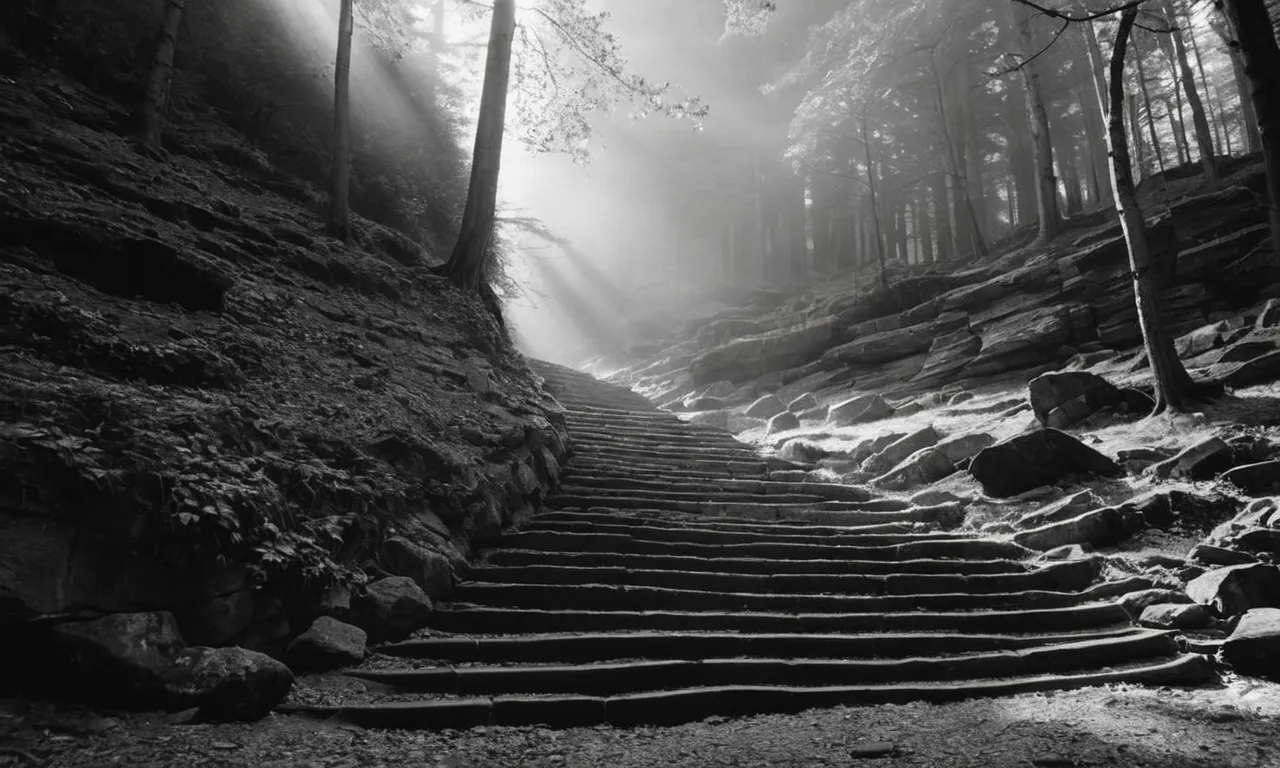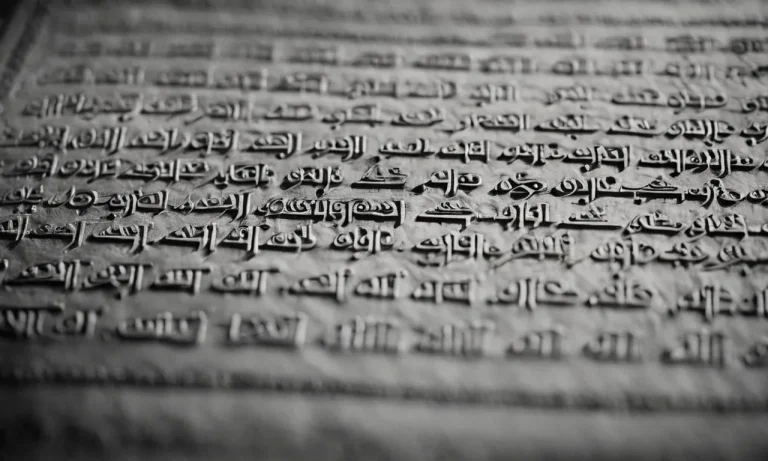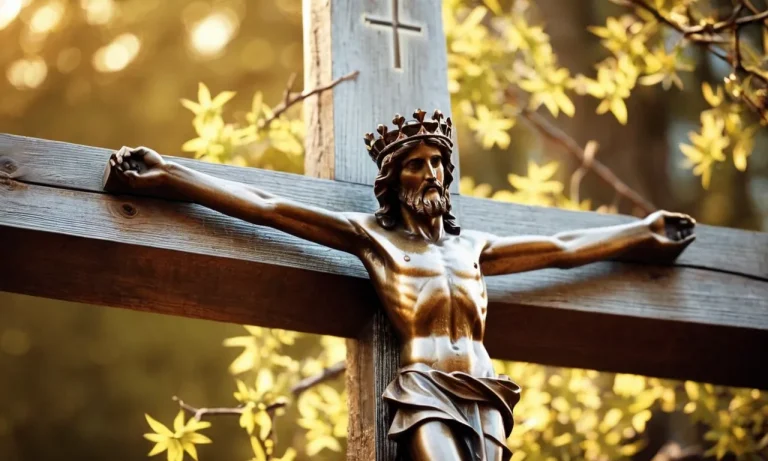How Many Steps Are In Jacob’S Ladder In The Bible?
The story of Jacob’s ladder is one of the most well-known passages in the Bible. Jacob dreams of a stairway reaching up to heaven with angels ascending and descending on it. This vivid image has captured people’s imaginations for centuries, but just how tall was this heavenly staircase?
What does the number of steps signify?
If you’re short on time, here’s a quick answer to your question: the Bible does not specify an exact number of steps for Jacob’s ladder. It is described as a stairway to heaven with angels going up and down, but no number is given.
In this approximately 3,000 word article, we will dive deep into the story of Jacob’s ladder to analyze what the image represents. We’ll look at various interpretations by biblical scholars over the years regarding the symbolism and meaning behind the ladder. Key questions we’ll explore include:
The Story of Jacob’s Ladder in Genesis
Jacob’s Dream at Bethel
As described in Genesis 28:10-22, Jacob was traveling to Haran when he stopped for the night and used a stone as a pillow to lay his head. As he slept, Jacob had a vivid dream of a stairway resting on the earth with its top reaching to heaven with angels of God were ascending and descending on it.
The Lord stood above the stairway and said, “I am the Lord, the God of your father Abraham and the God of Isaac. The land on which you are lying I will give to you and your offspring.”
Angels Ascending and Descending
This stairway, which became known as Jacob’s ladder, had angels going up and down between heaven and earth, likely as messengers delivering news to God and then carrying out His will. The specific mention of angels ascending and descending emphasizes the stairway’s role as a connection between heaven and earth.
According to Encyclopaedia Britannica, some scholars believe Jacob’s ladder signifies that the righteous can communicate with God through prayer, establishing a spiritual bridge between God and humanity.
God’s Covenant with Jacob
After Jacob awoke from his dream, God spoke to him and made a covenantal blessing. God promised Jacob that his descendants would be as numerous as “the dust of the earth” and they would spread out in all directions to inhabit the promised land of Canaan.
Additionally, God vowed, “I am with you and will watch over you wherever you go.” In response, Jacob took the stone he had used as a pillow, set it upright as a pillar, and declared the place Bethel, which means “house of God.”
This signified the special connection between God and this place where Jacob had his transformative dream vision.
Though the text does not specify how many steps were on Jacob’s ladder, its significance lies in being a bridge between heaven and earth. The number of steps is not as important as the spiritual symbolism of the angels traversing up and down in service of God’s will.
The ladder represented ongoing communication and relationship between God and humanity made possible by dutiful messengers.
Metaphorical Meanings Behind Jacob’s Ladder
Stairway to Heaven
In the Bible, Jacob’s ladder represents a stairway between heaven and earth. This metaphorical ladder appears to Jacob in a dream, with angels ascending and descending on it (Genesis 28:12). For many, Jacob’s ladder symbolizes the connection between the divine realm and the earthly one.
It is seen as a path that enables two-way communication between God and humanity.
Jacob’s ladder can be interpreted as a bridge between mortal existence on earth and the afterlife in heaven. The ladder provides a means for divine messengers (angels) to descend to earth and for human souls to ascend to heaven after death.
So in this sense, it serves as a transitional portal between this life and the next.
Christians often associate Jacob’s ladder with Christ’s later proclamation that He is “the way, the truth, and the life” (John 14:6). Just as the ladder connects heaven and earth, Christ bridges the gap between God and humanity through His incarnation.
He makes divine salvation available to believers, enabling their souls to ascend to heaven.
Bridge Between Heaven and Earth
Jacob’s ladder has been viewed by some biblical scholars as a symbolic bridge or portal between heaven and earth. This ladder enabled two-way traffic between the divine realm and the mortal realm.
In his dream, Jacob saw angels ascending and descending this ladder, indicating that it provided a means for messengers and communication to travel between realms. As a bridge, the ladder opened up access between the earthly and the heavenly, between humanity and God.
Some Jewish mystical texts expand on Jacob’s ladder, seeing it as a vertical axis connecting all realms of existence – from the earthly physical plane to the highest divine realms. In this view, the ladder spans and integrates all dimensions of creation.
Later in the New Testament, Christ proclaimed He was the only way to the Father (John 14:6). Christians have long seen Christ as the new ladder or bridge between heaven and earth, restoring access to the presence of God through His incarnation, death, and resurrection.
Path to Spiritual Enlightenment
In Eastern religions like Buddhism, Jacob’s ladder can represent the path to enlightenment. The upward climb of the ladder conveys the spiritual journey of individuals as they progress through stages of moral refinement.
Each rung of the ladder symbolizes a step towards greater virtue, self-awareness, and transcendence. Reaching the top rung represents the lofty goal of achieving nirvana, a state of ultimate peace and release from suffering.
For some Buddhist teachers, the ladder’s presence in a dream signifies that the dreamer is embarking on the path to enlightenment. The angels moving up and down the ladder represent helpful guides or enlightened beings assisting the individual on their spiritual journey.
So in this interpretation, Jacob’s ladder serves as an allegory for spiritual evolution. The gradual upward ascent corresponds to the advancement through levels of wisdom on the quest for self-realization and unity with the divine.
Numerical Symbolism of Biblical Numbers
Significance of the Number 7
The number 7 appears over 700 times in the Bible and signifies completion or perfection. God rested on the 7th day after creating the world in 6 days, according to Genesis. The 7 days in a week and the 7 feasts of Israel also relate to this special number.
12 Tribes and 12 Apostles
There were 12 tribes of Israel, originating from the 12 sons of Jacob in the Old Testament. Jesus later chose 12 apostles to represent the 12 tribes, signifying God’s people in the New Testament.
40 Days and 40 Nights of Rain
Noah’s flood lasted 40 days and 40 nights, a number that often represents a time of testing in the Bible. Moses stayed on Mount Sinai receiving the 10 commandments for 40 days and nights, and Jesus fasted in the wilderness for 40 days before starting his ministry.
For more details, check out these great references on biblical numerology: Significance of Numbers in Scripture, God’s Perfection and Completion
The Ladder as an Allegory of Prayer and Faith
Prayer as Ascent to God
Jacob’s ladder can be understood as an allegory for prayer and growing closer to God. Through focused prayer and meditation, one ascends rung by rung towards divine wisdom and grace. As Saint John Climacus wrote in the seventh century text The Ladder of Divine Ascent, prayer requires great perseverance but leads ultimately to illumination and union with the divine.
He describes 30 rungs on this ladder, which represent virtues attained gradually through discipline.
Virtues Gained Step-by-Step
The rungs on Jacob’s ladder symbolize virtues and spiritual qualities to be gained little by little with God’s help. For example, the lower rungs represent renunciation of worldliness, obedience, repentance and mourning. As one climbs higher, one attains virtues like discernment, humility and love.
At the top is the rung of perfect faith, hope and love. Just as ascending a ladder requires effort and balance, growing spiritually requires commitment to prayer, acting ethically and purifying oneself of negative qualities.
Ladder of Divine Ascent
In his book The Ladder of Divine Ascent, St. John Climacus compares the spiritual life to climbing a ladder to God. He describes 30 “rungs”, which represent virtues to be acquired. The ladder begins with renouncing worldliness and obedience to a spiritual guide.
Further rungs include repentance, meditation and austerity. As one ascends higher, one attains more refined virtues like discernment, humility and love. At the summit are the theological virtues of perfect faith, hope and love.
Climacus argues that the spiritual ladder is climbed through commitment to monastic practices like prayer, asceticism, solitude and detachment. However, his teachings apply to all striving to grow in the spiritual life.
Later Traditions about Jacob’s Ladder
References in Jewish Mysticism
The story of Jacob’s ladder became an important symbol in Jewish mysticism. In the Zohar, the classic text of Kabbalah, the ladder represents the progressive “stages of ascent” to God. The Zohar interprets Jacob’s ladder as a symbol of the cosmos and its connection between the material world and the heavenly world.
The 12 steps of the ladder were said to correspond to the 12 tribes of Israel.
Later Jewish thinkers expanded upon the symbolism of Jacob’s ladder. Moses Cordovero, a 16th century Kabbalist, associated each rung of the ladder with one of the Ten Sefirot – the divine emanations through which God reveals himself.
Others saw the ladder as a representation of various spiritual disciplines and virtues that must be cultivated in order to draw closer to the divine.
The Ladder in Christian Art and Hymns
In Christian tradition, Jacob’s ladder became a symbol of Christ, providing a bridge between heaven and earth. Artists commonly depicted the ladder in church paintings and stained glass. A famous example is a fresco by the Renaissance painter Andrea del Sarto in the Chiostro dello Scalzo, Florence, painted around 1517.
The ladder is also featured in popular hymns. One well-known hymn written in 1864 by William O. Cushing refers to Christ providing a “ladder of light” to guide people to heaven. Another hymn from 1712 by Henry Purcell is titled “Jacob’s Ladder.”
It uses the ladder as a metaphor for God’s grace elevating sinners to salvation.
Modern Allusions and Uses of the Symbol
Even in modern times, Jacob’s ladder remains a familiar symbol. Nobel Prize-winning author William Faulkner used it as the title for his novel The Sound and the Fury (1929). More recently, the 1990 film Jacob’s Ladder used the concept as a psychological metaphor.
The original biblical ladder has inspired many other ladder symbols too. The ceremonial maces used in the British House of Commons and House of Lords are modeled after Jacob’s ladder. Organizations such as the Odd Fellows have incorporated ladder symbols into their emblems.
Even children’s toys like the Jacob’s Ladder climbing string have taken their name from the famous biblical story.
Conclusion
In the end, the key takeaway from the story of Jacob’s ladder is not about the number of physical steps. Rather, it serves as a vivid symbol of the connection between heaven and earth, God reaching down to humanity.
Over many centuries, scholars and artists have interpreted the ladder as an allegory for the progression of spiritual enlightenment.
While the Bible does not specify an exact number of steps on Jacob’s ladder, the image conveys the infinite transcendence of God and the angelic realm. The ladder also represents continuous movement, with angels eternally ascending and descending in service of the divine.
This timeless story continues to inspire people to strengthen their relationship with the heavenly through prayer and contemplation.








